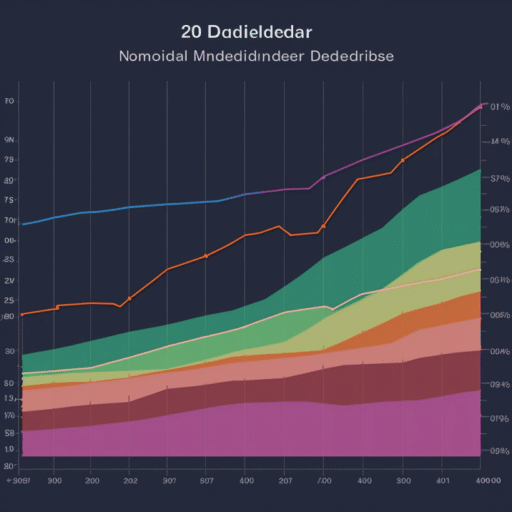The financial landscape continually evolves, and among its most stable components are dividend indexes. When discussing the best indexes for dividends, we highlight avenues where investors aim for consistent returns and a reliable income stream.
If you are looking to invest as an expat or high-net-worth individual, which is what I specialize in, you can email me (advice@adamfayed.com) or WhatsApp (+44-7393-450-837).
This includes if you are looking for a second opinion or alternative investments.
Some of the facts might change from the time of writing, and nothing written here is financial, legal, tax or any kind of individual advice, nor a solicitation to invest.
What are Dividend Indexes?
Dividend indexes spotlight companies renowned for distributing dividends to their shareholders. These dividends, essentially a slice of a company’s profits, serve as a testament to its financial health and commitment to its investors.
The best indexes for dividends don’t just spotlight any dividend-paying company; they prioritize those that have a track record of consistent and growing payouts.
The Importance of Dividends in Investment Strategy
Dividends aren’t just additional income; they’re a reflection of a company’s stability and promise. Especially during times of market uncertainty, dividends can be a reassuring sign for investors.
By zeroing in on the best indexes for dividends, investors position themselves to benefit from both the growth of their principal investment and the regular income from dividends.
Recent data from Hartford Funds indicates that from 1930–2022, dividend income contributed to an average of 41% of the total return of the S&P 500 Index.

How Dividend Indexes Differ from Other Indexes
While some indexes might be swayed by market capitalization or potential for rapid growth, the best indexes for dividends have a different focus. They zero in on dividend yield, the consistency of those dividends, and the potential for dividend growth.
For instance, the S&P 500 High Dividend Index serves as a benchmark specifically tailored for those seeking income from equity investments, measuring the performance of high-yield companies.
On the other hand, the S&P U.S. Dividend Growers Index reported that U.S. Common Indicated Dividend Payments increased to $4.3 Billion during Q2 2023, with a 12-Month Gain of $46.3 Billion, showcasing the growth potential in dividend payments.
The Criteria for Selecting the Best Dividend Indexes
Choosing the best indexes for dividends requires a keen understanding of several factors.
Yield Consistency
The best indexes for dividends consistently offer high yields. A consistent yield indicates a company’s commitment to returning value to its shareholders.
When investors look for the best indexes for dividends, they often prioritize those that have a history of providing steady and reliable returns. This consistency can be a sign of the index’s overall stability and its potential to continue delivering dividends in the future.
Historical Performance
Past performance often indicates future results. The best indexes for dividends have a track record of outperforming others in both bull and bear markets.
For instance, the Dow Jones U.S. Select Dividend Index and the S&P Global Dividends Opportunity Index are among the top dividend indices recognized for their performance.
These indexes have demonstrated their ability to provide investors with consistent returns over time, making them some of the best indexes for dividends.
Diversification and Sector Allocation
Diversification reduces risk. The best indexes for dividends ensure a spread across various sectors, ensuring that a downturn in one sector doesn’t heavily impact the entire index.
For example, the Dow Jones U.S. Select Dividend Index is heavily weighted towards historically higher-yield sectors like utilities and consumer goods. This diversification can help protect investors from significant losses if one sector underperforms.
Global Opportunities
While many investors focus on domestic markets, it’s essential to recognize that dividend opportunities exist globally.
The S&P Global Dividends Opportunity Index, for instance, encompasses roughly 100 high-yielding stocks worldwide. However, only 33% of its assets come from the U.S., indicating its broad global reach.
This international diversification can offer investors exposure to high-yielding opportunities outside their home country, making it one of the best indexes for dividends for those looking to diversify globally.
Expense Ratios and Management Fees
Low fees mean higher returns for investors. The best indexes for dividends come with reasonable expense ratios and management fees. It’s crucial for investors to be aware of the costs associated with investing in an index.
High fees can erode returns, especially over the long term. Therefore, when searching for the best indexes for dividends, always consider the associated fees and ensure they align with your investment goals.

Recognizing Top Dividend Funds
While individual indexes are crucial, it’s also beneficial to recognize top dividend funds that might be benchmarked to these indexes. Funds like the ProShares S&P 500 Dividend Aristocrats Index and the NASDAQ U.S.
Dividend Achievers Select Index have become popular among investors. These funds often consist of companies that have a history of raising their dividends, making them attractive options for those seeking the best indexes for dividends.
Overview of the 7 Best Indexes for Dividends
Gaining insights into the best indexes for dividends offers a strategic advantage for investors aiming to maximize their returns. Let’s explore the distinct features of these indexes.
The financial landscape boasts a variety of dividend indexes, each with its unique attributes. By understanding the nuances of the best indexes for dividends, investors can make informed decisions tailored to their financial goals.
Key Characteristics of Leading Dividend Indexes
Dividend investing remains a potent strategy for wealth accumulation over the long term. Companies that consistently pay dividends often generate substantial income and cash flow, sharing these profits with investors.
The best indexes for dividends capture this essence, focusing on companies that prioritize shareholder returns.
The Evolving Landscape of Dividend Investing
While high-growth stocks often dominate headlines, dividends continue to contribute significantly to an investment’s total return.
They offer a regular income stream that persists despite market fluctuations. The best indexes for dividends capture this dynamic, focusing on companies that consistently reward shareholders.
The Role of Mature Companies
Mature or conservative companies, having surpassed their aggressive growth phases, often allocate a significant portion of their excess cash flow to shareholders in the form of dividends. These companies form the backbone of many of the best indexes for dividends.
Diverse Objectives of Dividend-Oriented Investments
Not all dividend-focused investments share the same goals. Various dividend-centric mutual funds and ETFs benchmark to indexes with differing objectives. By understanding these nuances, investors can select the best indexes for dividends that align with their investment strategy.
1. S&P 500 Dividend Aristocrats
The S&P 500 Dividend Aristocrats, recognized as one of the best indexes for dividends, consistently showcases its reliability and performance.
The S&P 500 Dividend Aristocrats, as defined by S&P Global, measures the performance of S&P 500 companies that have consistently increased their dividends every year for the last 25 consecutive years. This commitment to shareholders has made it a preferred choice among dividend investors.
Criteria for Inclusion
Being part of the S&P 500 Dividend Aristocrats isn’t a simple feat. Companies must not only grow their dividends but do so with unwavering consistency. This consistent growth is a testament to their financial robustness and dedication to their shareholders.
Furthermore, as highlighted by Investopedia, these stocks should have a float-adjusted market capitalization of at least $3 billion and maintain an average daily trading volume.
Sector Allocation
Diversification is a hallmark of the best indexes for dividends. The S&P 500 Dividend Aristocrats doesn’t disappoint in this regard. It encompasses a variety of sectors, ensuring that investors have a well-rounded exposure, mitigating risks associated with any single sector’s downturn.
Performance Analysis
Historical data reveals that the S&P 500 Dividend Aristocrats frequently surpasses many other indexes in performance. This consistent outperformance cements its position as one of the best indexes for dividends.

A research article by S&P Global points out that the S&P 500 Dividend Aristocrats exhibits both capital growth and dividend income characteristics. This dual advantage makes it a compelling choice for those seeking both income and appreciation.
Current Trends and Insights
The S&P 500 Dividend Aristocrats continues to evolve, reflecting the dynamic nature of the market. As of July 31, 2019, the S&P High Yield Dividend Aristocrats reported a dividend yield of 2.8%, outperforming the yields of several other securities and indices.
Moreover, the Barron’s overview of the S&P 500 Dividend Aristocrats Index indicates a 5.92% change over the past 12 months, highlighting its resilience and potential for growth.
The Broader Impact
The influence of the S&P 500 Dividend Aristocrats extends beyond just its constituents. It sets a benchmark for other companies in the S&P 500, encouraging them to prioritize shareholder returns.
As more companies strive to join this elite group, investors can anticipate a broader market trend emphasizing consistent dividend growth.
2. Dow Jones U.S. Select Dividend Index
The Dow Jones U.S. Select Dividend Index stands out as one of the best indexes for dividends, offering investors a blend of consistent returns and high dividend yields.
Launched to track high dividend-yielding U.S. companies, the Dow Jones U.S. Select Dividend Index has become a go-to for those seeking consistent returns. Representing the U.S.’s leading stocks by dividend yield, it has built a reputation as one of the best indexes for dividends.
Criteria for Inclusion
The strength of the Dow Jones U.S. Select Dividend Index lies in its rigorous selection process. Companies within this index have a commendable history of paying dividends.
The primary focus for inclusion revolves around the dividend payout ratio and growth, ensuring that only firms with a robust dividend-paying track record make the cut. This meticulous selection process reinforces its position as one of the best indexes for dividends.
Sector Allocation
A diversified portfolio is a resilient one. This index ensures a balanced representation from various sectors, reducing the impact of any single sector’s downturn on the overall performance.
Such diversification is a hallmark of the best indexes for dividends, and the Dow Jones U.S. Select Dividend Index is no exception.
Performance Analysis
When it comes to performance, the Dow Jones U.S. Select Dividend Index has consistently showcased its prowess. Historically, it has often surpassed market averages, further solidifying its position as one of the best indexes for dividends.
Recent data from S&P Global highlights its aim to represent the U.S.’s leading stocks by dividend yield, making it a preferred choice for dividend-focused investors.
Index-Linked Products
For investors looking to tap into the potential of the Dow Jones U.S. Select Dividend Index, several index-linked products are available. Some notable ones include:
- ARIRANG DJ US Select Dividend (Synth H) – An ETF based in South Korea with the ticker 213630.
- iShares DJ US Select Dividend (DE) – An ETF with no specific country of origin.
- iShares Select Dividend ETF – A U.S.-based ETF with the ticker DVY.
- KSM ETF (4A) DJ US Dividend Currency Hedged – An ETF from Israel with the ticker KSMF145.
These products offer investors a way to leverage the performance of one of the best indexes for dividends without directly investing in each constituent stock.
3. ProShares S&P 500 Dividend Aristocrats
The ProShares S&P 500 Dividend Aristocrats ETF is a prominent figure among the best indexes for dividends, offering a blend of consistent returns and high dividend yields from top-performing S&P 500 companies.
Designed to track the performance of the S&P 500® Dividend Aristocrats® Index, the ProShares S&P 500 Dividend Aristocrats ETF focuses on high-quality companies within the S&P 500 that have not only paid dividends but have consistently grown them.
This commitment to dividend growth and consistency has cemented its reputation as one of the best indexes for dividends.
Criteria for Inclusion
The strength of the ProShares S&P 500 Dividend Aristocrats ETF lies in its selection of companies that have a proven track record of dividend growth. Specifically, it targets companies that have increased their dividends every year for at least 25 consecutive years.
This rigorous selection ensures that the ETF comprises firms that demonstrate financial stability and a commitment to returning value to shareholders, making it one of the best indexes for dividends.
Sector Allocation
Diversification is paramount for any investment strategy. The ProShares S&P 500 Dividend Aristocrats ETF ensures a balanced representation from various sectors of the S&P 500, mitigating the risks associated with overexposure to any single sector.
This balanced sector allocation is a defining feature of the best indexes for dividends.
Performance Analysis
The ProShares S&P 500 Dividend Aristocrats ETF has consistently showcased its ability to deliver returns that often surpass market averages.
By focusing on companies with a history of dividend growth, it offers both capital appreciation and income potential, solidifying its position as one of the best indexes for dividends.
Index-Linked Products
For those interested in leveraging the performance of the ProShares S&P 500 Dividend Aristocrats without directly investing in the ETF, there are several index-linked products available.
Some of these products include the ARIRANG DJ US Select Dividend (Synth H), iShares DJ US Select Dividend (DE), and the iShares Select Dividend ETF. These products provide investors with diverse options to benefit from one of the best indexes for dividends.

4. NASDAQ U.S. Dividend Achievers Select Index
The NASDAQ U.S. Dividend Achievers Select Index is a prominent figure among the best indexes for dividends, offering a blend of high dividend yields and consistent performance.
The NASDAQ U.S. Dividend Achievers™ Select Index is designed to track U.S. companies known for their impressive dividend yields.
Established on March 29, 2006, with a base value of 1,169.75, this index has since been a beacon for investors seeking both dividend consistency and growth. Its rich history and performance make it one of the best indexes for dividends.
Criteria for Inclusion
The NASDAQ U.S. Dividend Achievers Select Index places a premium on dividend consistency. The NASDAQ U.S. Dividend Achievers Select Index has a stringent selection process that ensures only the cream of the dividend-paying crop gets included.
Companies that find a place in this index have consistently demonstrated a commitment to rewarding shareholders through dividends. The primary criteria for inclusion revolve around a history of increasing dividends, ensuring that the index remains one of the best indexes for dividends.
Sector Allocation
Diversification is at the heart of the NASDAQ U.S. Dividend Achievers Select Index’s approach. It ensures a well-balanced representation from various sectors, offering investors exposure to a broad spectrum of the market while minimizing the risks associated with overexposure to any single sector.
This diversification strategy has played a pivotal role in its recognition as one of the best indexes for dividends.
Performance Analysis
Over the years, the NASDAQ U.S. Dividend Achievers Select Index has showcased commendable performance, often outpacing many of its peers.
Its track record of consistent returns, combined with its focus on high dividend-yielding companies, cements its position as one of the best indexes for dividends. Investors who have aligned their portfolios with this index have enjoyed both capital appreciation and a steady stream of income.
While the NASDAQ U.S. Dividend Achievers Select Index offers a promising avenue for dividend-focused investments, it’s always crucial for investors to conduct their research and align their choices with their financial goals and risk tolerance.
Index-Linked Products
For those interested in leveraging the performance of the ProShares S&P 500 Dividend Aristocrats without directly investing in the ETF, there are several index-linked products available.
Some of these products include the ARIRANG DJ US Select Dividend (Synth H), iShares DJ US Select Dividend (DE), and the iShares Select Dividend ETF. These products provide investors with diverse options to benefit from one of the best indexes for dividends.
Pained by financial indecision?

Adam is an internationally recognised author on financial matters with over 830million answer views on Quora, a widely sold book on Amazon, and a contributor on Forbes.


